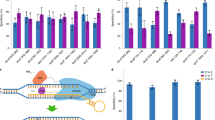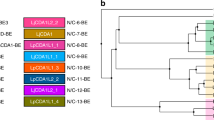Abstract
Base editors show promise for treating human genetic diseases, but most current systems use deaminases, which cause off-target effects and are limited in editing type. In this study, we constructed deaminase-free base editors for cytosine (DAF-CBE) and thymine (DAF-TBE), which contain only a cytosine-DNA or a thymine-DNA glycosylase (CDG/TDG) variant, respectively, tethered to a Cas9 nickase. Multiple rounds of mutagenesis by directed evolution in Escherichia coli generated two variants with enhanced base-converting activity—CDG-nCas9 and TDG-nCas9—with efficiencies of up to 58.7% for C-to-A and 54.3% for T-to-A. DAF-BEs achieve C-to-G/T-to-G editing in mammalian cells with minimal Cas9-dependent and Cas9-independent off-target effects as well as minimal RNA off-target effects. Additional engineering resulted in DAF-CBE2/DAF-TBE2, which exhibit altered editing windows from the 5′ end to the middle of the protospacer and increased C-to-G/T-to-G editing efficiency of 3.5-fold and 1.2-fold, respectively. Compared to prime editing or CGBEs, DAF-BEs expand conversion types of base editors with similar efficiencies, smaller sizes and lower off-target effects.
This is a preview of subscription content, access via your institution
Access options
Access Nature and 54 other Nature Portfolio journals
Get Nature+, our best-value online-access subscription
$29.99 / 30 days
cancel any time
Subscribe to this journal
Receive 12 print issues and online access
$209.00 per year
only $17.42 per issue
Buy this article
- Purchase on Springer Link
- Instant access to full article PDF
Prices may be subject to local taxes which are calculated during checkout






Similar content being viewed by others
Data availability
The high-throughput sequencing data have been deposited in the National Center for Biotechnology Information database with accession codes PRJNA900229 and PRJNA1001163 (refs. 42,43). Source data for Figs. 2–4 and 6 and Supplementary Figs. 4 and 5 are presented with the paper. There are no restrictions on data availability. Source data are provided with this paper.
References
Komor, A. C., Kim, Y. B., Packer, M. S., Zuris, J. A. & Liu, D. R. Programmable editing of a target base in genomic DNA without double-stranded DNA cleavage. Nature 533, 420–424 (2016).
Nishida, K. et al. Targeted nucleotide editing using hybrid prokaryotic and vertebrate adaptive immune systems. Science 353, aaf8729 (2016).
Gaudelli, N. M. et al. Programmable base editing of A•T to G•C in genomic DNA without DNA cleavage. Nature 551, 464–471 (2017).
Zhao, D. et al. Glycosylase base editors enable C-to-A and C-to-G base changes. Nat. Biotechnol. 39, 35–40 (2021).
Kurt, I. C. et al. CRISPR C-to-G base editors for inducing targeted DNA transversions in human cells. Nat. Biotechnol. 39, 41–46 (2021).
Tong, H. et al. Programmable A-to-Y base editing by fusing an adenine base editor with an N-methylpurine DNA glycosylase. Nat. Biotechnol. 41, 1080–1084 (2023).
Chen, L. et al. Adenine transversion editors enable precise, efficient A•T-to-C•G base editing in mammalian cells and embryos. Nat. Biotechnol. https://doi.org/10.1038/s41587-023-01821-9 (2023).
Tong, H. et al. Programmable deaminase-free base editors for G-to-Y conversion by engineered glycosylase. Natl Sci. Rev. 10, nwad143 (2023).
Grunewald, J. et al. Transcriptome-wide off-target RNA editing induced by CRISPR-guided DNA base editors. Nature 569, 433–437 (2019).
Jin, S. et al. Cytosine, but not adenine, base editors induce genome-wide off-target mutations in rice. Science 364, 292–295 (2019).
Zuo, E. et al. Cytosine base editor generates substantial off-target single-nucleotide variants in mouse embryos. Science 364, 289–292 (2019).
Rees Holly, A., Wilson, C., Doman Jordan, L. & Liu David, R. Analysis and minimization of cellular RNA editing by DNA adenine base editors. Sci. Adv. 5, eaax5717 (2019).
Zhou, C. et al. Off-target RNA mutation induced by DNA base editing and its elimination by mutagenesis. Nature 571, 275–278 (2019).
Park, S. & Beal, P. A. Off-target editing by CRISPR-guided DNA base editors. Biochemistry 58, 3727–3734 (2019).
McCulloch, S. D. & Kunkel, T. A. The fidelity of DNA synthesis by eukaryotic replicative and translesion synthesis polymerases. Cell Res. 18, 148–161 (2008).
Kantor, A., McClements, M. E. & MacLaren, R. E. CRISPR-Cas9 DNA base-editing and prime-editing. Int. J. Mol. Sci. 21, 6240 (2020).
Mol, C. D. et al. Crystal structure and mutational analysis of human uracil-DNA glycosylase: structural basis for specificity and catalysis. Cell 80, 869–878 (1995).
Kavli, B. et al. Excision of cytosine and thymine from DNA by mutants of human uracil-DNA glycosylase. EMBO J. 15, 3442–3447 (1996).
Richter, M. F. et al. Phage-assisted evolution of an adenine base editor with improved Cas domain compatibility and activity. Nat. Biotechnol. 38, 883–891 (2020).
Koblan, L. W. et al. Efficient C•G-to-G•C base editors developed using CRISPRi screens, target-library analysis, and machine learning. Nat. Biotechnol. 39, 1414–1425 (2021).
Nelson, J. W. et al. Engineered pegRNAs improve prime editing efficiency. Nat. Biotechnol. 40, 402–410 (2022).
Doman, J. L., Raguram, A., Newby, G. A. & Liu, D. R. Evaluation and minimization of Cas9-independent off-target DNA editing by cytosine base editors. Nat. Biotechnol. 38, 620–628 (2020).
Koblan, L. W. et al. Improving cytidine and adenine base editors by expression optimization and ancestral reconstruction. Nat. Biotechnol. 36, 843–846 (2018).
Li, B. et al. Sequence motifs and prediction model of GBE editing outcomes based on target library analysis and machine learning. J. Genet. Genomics 49, 254–257 (2022).
Walton, R. T., Christie, K. A., Whittaker, M. N. & Kleinstiver, B. P. Unconstrained genome targeting with near-PAMless engineered CRISPR–Cas9 variants. Science 368, 290–296 (2020).
Verloes, A., et al. WDR62 Primary Microcephaly. In GeneReviews® (eds Adam, M. P. et al.) (Univ. of Washington, 1993).
Elborn, J. S. Cystic fibrosis. Lancet 388, 2519–2531 (2016).
Huang, T. P. et al. Circularly permuted and PAM-modified Cas9 variants broaden the targeting scope of base editors. Nat. Biotechnol. 37, 626–631 (2019).
Jiang, G. et al. Molecular mechanism of the cytosine CRISPR base editing process and the roles of translesion DNA polymerases. ACS Synth. Biol 10, 3353–3358 (2021).
Wang, Y. et al. Engineering of the translesion DNA synthesis pathway enables controllable C-to-G and C-to-A base editing in Corynebacterium glutamicum. ACS Synth. Biol. 11, 3368–3378 (2022).
Datsenko, K. A. & Wanner, B. L. One-step inactivation of chromosomal genes in Escherichia coli K-12 using PCR products. Proc. Natl Acad. Sci. USA 97, 6640–6645 (2000).
Engler, C., Kandzia, R. & Marillonnet, S. A one pot, one step, precision cloning method with high throughput capability. PLoS ONE 3, e3647 (2008).
Zhao, J. et al. Engineering central metabolic modules of Escherichia coli for improving β-carotene production. Metab. Eng. 17, 42–50 (2013).
Feng, X., Zhao, D., Zhang, X., Ding, X. & Bi, C. CRISPR/Cas9 assisted multiplex genome editing technique in Escherichia coli. Biotechnol. J. 13, e1700604 (2018).
Kluesner, M. G. et al. EditR: a method to quantify base editing from Sanger sequencing. CRISPR J. 1, 239–250 (2018).
Wang, X. et al. The EF-1α promoter maintains high-level transgene expression from episomal vectors in transfected CHO-K1 cells. J. Cell. Mol. Med. 21, 3044–3054 (2017).
Chow, R. D., Chen, J. S., Shen, J. & Chen, S. A web tool for the design of prime-editing guide RNAs. Nat. Biomed. Eng. 5, 190–194 (2021).
Bae, S., Park, J. & Kim, J. S. Cas-OFFinder: a fast and versatile algorithm that searches for potential off-target sites of Cas9 RNA-guided endonucleases. Bioinformatics 30, 1473–1475 (2014).
Hwang, G.-H. et al. Web-based design and analysis tools for CRISPR base editing. BMC Bioinformatics 19, 542 (2018).
Sun, N. et al. Reconstructed glycosylase base editors GBE2.0 with enhanced C-to-G base editing efficiency and purity. Mol. Ther. 30, 2452–2463 (2022).
Wang, L. et al. Eliminating base-editor-induced genome-wide and transcriptome-wide off-target mutations. Nat. Cell Biol. 23, 552–563 (2021).
CBC/TBC editing data: development of two new base editors. National Institutes of Health. National Library of Medicine. National Center for Biotechnology Information. BioProject PRJNA900229 (2022).
DAF-BE: the DAF (deaminase free)-CBE/TBE efficiently converts C/T to G in mammalian cells. National Institutes of Health. National Library of Medicine. National Center for Biotechnology Information. BioProject PRJNA1001163 (2023).
Acknowledgements
This research was financially supported by the National Key Research and Development Program of China (2019YFA0904900); the National Natural Science Foundation of China (32225031, 32171449, 32271483, 32001041 and 81903776); the Tianjin Synthetic Biotechnology Innovation Capacity Improvement Project (TSBICIP-KJGG-017); the Youth Innovation Promotion Association, Chinese Academy of Sciences (2022177); and the Tianjin Natural Science Foundation (20JCYBJC00310). The authors thank Zibing Jin (Capital Medical University, China) for providing hiPSCs.
Author information
Authors and Affiliations
Contributions
X.Z. and C.B. designed the research, analyzed data and wrote the manuscript. L.Y. and D.Z. designed the research, performed experiments, analyzed data and wrote the manuscript. J.L. and S.L. designed the research. Y.W., B.L., X.H., H.W., Z.W., X.L. and Y.L. performed experiments. Y.Y. and Y.L. analyzed data.
Corresponding authors
Ethics declarations
Competing interests
X.Z., C.B., L.Y. and D.Z. jointly filed patent applications on DAF-BEs.
Peer review
Peer review information
Nature Biotechnology thanks the anonymous reviewers for their contribution to the peer review of this work.
Additional information
Publisher’s note Springer Nature remains neutral with regard to jurisdictional claims in published maps and institutional affiliations.
Supplementary information
Supplementary Information
Supplementary Figs. 1–7, Supplementary Tables 1–9 and Supplementary Sequences 1–3
Supplementary Data 1
Statistical Source Data
Supplementary Data 2
Statistical Source Data
Source data
Source Data Fig. 2
Statistical Source Data
Source Data Fig. 3
Statistical Source Data
Source Data Fig. 4
Statistical Source Data
Source Data Fig. 6
Statistical Source Data
Rights and permissions
Springer Nature or its licensor (e.g. a society or other partner) holds exclusive rights to this article under a publishing agreement with the author(s) or other rightsholder(s); author self-archiving of the accepted manuscript version of this article is solely governed by the terms of such publishing agreement and applicable law.
About this article
Cite this article
Ye, L., Zhao, D., Li, J. et al. Glycosylase-based base editors for efficient T-to-G and C-to-G editing in mammalian cells. Nat Biotechnol (2024). https://doi.org/10.1038/s41587-023-02050-w
Received:
Accepted:
Published:
DOI: https://doi.org/10.1038/s41587-023-02050-w



